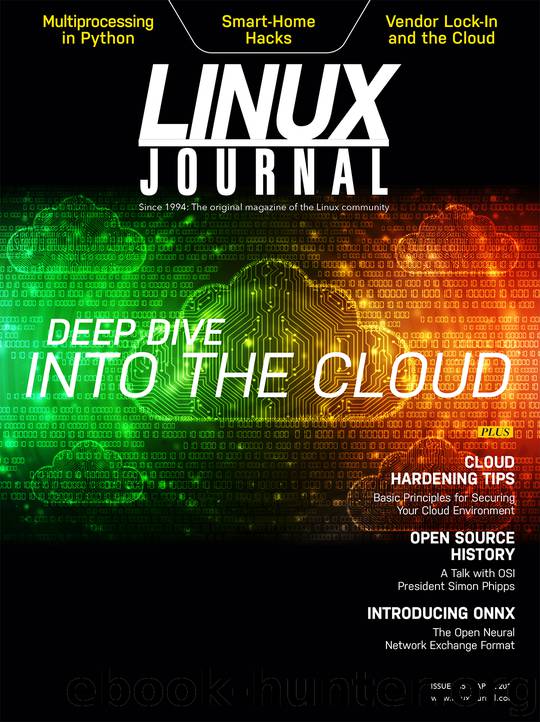Linux Journal April 2018 by Linux Journal

Author:Linux Journal
Language: eng
Format: mobi
Published: 2018-03-28T05:00:00+00:00
Figure 2. Illustrating the Difference between Running Application on Bare-Metal Systems, Hypervisors and Containers
Containers
Containers are about as close to bare metal that you can get when running virtual machines. Hosting virtual machines imposes very little to no overhead. This feature limits, accounts for and isolates CPU, memory, disk I/O and network usage of one or more processes. Essentially, containers decouple software applications from the operating system, giving users a clean and minimal operating environment while running everything else in one or more isolated "containers".
This isolation prevents processes running within a given container from monitoring or affecting processes running in another container. Also, these containerized services do not influence or disturb the host machine. The idea of being able to consolidate many services scattered across multiple physical servers into one is one of the many reasons data centers have chosen to adopt the technology. This method of isolation adds to the security of the technology by limiting the damage caused by a security breach or violation. An intruder who successfully exploits a security hole on one of the applications running in that container is restricted to the set of actions possible within that container.
In the context of the cloud, containers simplify application deployment immensely by not only isolating the application from an entire operating system (virtualized or not) but also by being able to deploy with a bare minimum amount of requirements in both software and hardware, further reducing the headache of maintaining both.
Serverless Computing
Cloud native computing or serverless computing are more recent terms describing the more modern trend of deploying and managing applications. The idea is pretty straightforward. Each application or process is packaged into its own container, which, in turn, is orchestrated dynamically (that is, scheduled and managed) across a cluster of nodes. This approach moves applications away from physical hardware and operating system dependency and into their own self-contained and sandboxed environment that can run anywhere within the data center. The cloud native approach is about separating the various components of application delivery.
This may sound identical to running any other container in the cloud, but what makes cloud native computing so unique is that you don't need to worry about managing that container (meaning less overhead). This technology is hidden from the developer. Simply upload your code, and when a specified trigger is enabled, an API gateway (maintained by the service provider) deploys your code in the way it is intended to process that trigger.
The first thing that comes to mind here is Amazon's AWS Lambda. Again, under this model, there's no need to provision or manage physical or virtual servers. Assuming it's in a stable or production state, simply upload your code and you are done. Your code is just deployed within an isolated containerized environment. In the case with Lambda, Amazon has provided a framework for developers to upload their event-driven application code (written in Node.js, Python, Java or C#) and respond to events like website clicks within milliseconds. All libraries and dependencies to run the bulk of your code are provided for within the container.
Download
This site does not store any files on its server. We only index and link to content provided by other sites. Please contact the content providers to delete copyright contents if any and email us, we'll remove relevant links or contents immediately.
Test-Driven iOS Development with Swift 4 by Dominik Hauser(10406)
Filmora Efficient Editing by Alexander Zacharias(6713)
The Infinite Retina by Robert Scoble Irena Cronin(6220)
Learn Wireshark - Fundamentals of Wireshark. by Lisa Bock(4483)
Linux Device Driver Development Cookbook by Rodolfo Giometti(4052)
Edit Like a Pro with iMovie by Regit(3918)
Linux Administration Best Practices by Scott Alan Miller(2963)
Linux Command Line and Shell Scripting Techniques by Vedran Dakic & Jasmin Redzepagic(2914)
Mastering PowerShell Scripting - Fourth Edition by Chris Dent(2874)
Creative Projects for Rust Programmers by Carlo Milanesi(2712)
MCSA Windows Server 2016 Study Guide: Exam 70-740 by William Panek(2603)
Docker on Windows by Stoneman Elton(2393)
Kali Linux - An Ethical Hacker's Cookbook: End-to-end penetration testing solutions by Sharma Himanshu(2373)
Hands-On AWS Penetration Testing with Kali Linux by Karl Gilbert(2215)
Hands-On Linux for Architects by Denis Salamanca(2151)
Programming in C (4th Edition) (Developer's Library) by Stephen G. Kochan(2132)
Computers For Seniors For Dummies by Nancy C. Muir(2127)
The Old New Thing by Raymond Chen(2080)
Linux Kernel Debugging by Kaiwan N Billimoria(1838)
